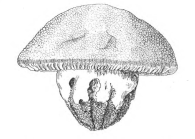WoRMS taxon details
Catostylus ouwensi Moestafa & McConnaughey, 1966
287175 (urn:lsid:marinespecies.org:taxname:287175)
accepted
Species
marine, brackish, fresh, terrestrial
recent only
Moestafa, S. H., & McConnaughey, B. H. (1966). <em>Catostylus ouwensi</em> (Rhizostomeae, Catostylidae), a new jellyfish from Irian (New Guinea) and <em>Ouwensia catostyli</em> n. gen., n. sp., parasitic in <em>C. ouwensi</em>. <em>Treubia.</em> 27(1): 1-9.
page(s): 1-4, figs 1-3 [details]
page(s): 1-4, figs 1-3 [details]
Holotype MZB Coel 031, geounit Irian Jaya
Holotype MZB Coel 031, geounit Irian Jaya [details]
Collins, A.G.; Morandini, A.C. (2024). World List of Scyphozoa. Catostylus ouwensi Moestafa & McConnaughey, 1966. Accessed through: World Register of Marine Species at: https://www.marinespecies.org/aphia.php?p=taxdetails&id=287175 on 2024-11-21
Date
action
by
![]() The webpage text is licensed under a Creative Commons Attribution 4.0 License
The webpage text is licensed under a Creative Commons Attribution 4.0 License
original description
Moestafa, S. H., & McConnaughey, B. H. (1966). <em>Catostylus ouwensi</em> (Rhizostomeae, Catostylidae), a new jellyfish from Irian (New Guinea) and <em>Ouwensia catostyli</em> n. gen., n. sp., parasitic in <em>C. ouwensi</em>. <em>Treubia.</em> 27(1): 1-9.
page(s): 1-4, figs 1-3 [details]
basis of record F.S. Cornelius and J. van der Land (eds), updates 2000-2007, as a contribution to UNESCO-IOC Register of Marine Organisms (look up in IMIS) [details]
additional source Jarms, G. & Morandini, A.C. (2019). World Atlas of Jellyfish. Dölling und Galitz Verlag, 816p.
page(s): 578-579 [details]
page(s): 1-4, figs 1-3 [details]
basis of record F.S. Cornelius and J. van der Land (eds), updates 2000-2007, as a contribution to UNESCO-IOC Register of Marine Organisms (look up in IMIS) [details]
additional source Jarms, G. & Morandini, A.C. (2019). World Atlas of Jellyfish. Dölling und Galitz Verlag, 816p.
page(s): 578-579 [details]
 Present
Present  Present in aphia/obis/gbif/idigbio
Present in aphia/obis/gbif/idigbio  Inaccurate
Inaccurate  Introduced: alien
Introduced: alien  Containing type locality
Containing type locality
Holotype MZB Coel 031, geounit Irian Jaya [details]
From editor or global species database
Additional information This species was only seen by the authors who described it based on 5 specimens; no further mention in the literature [details]

